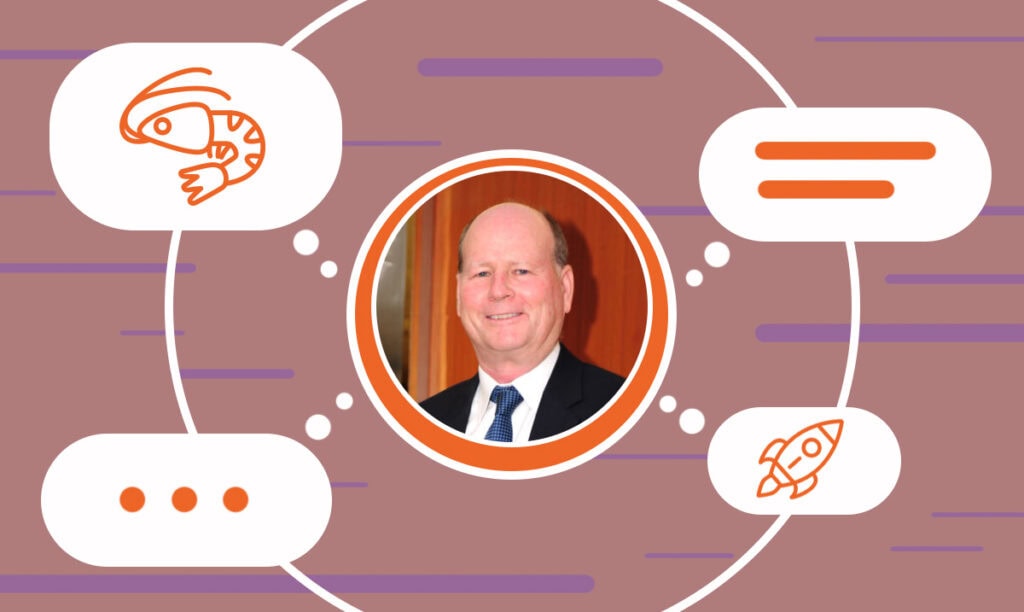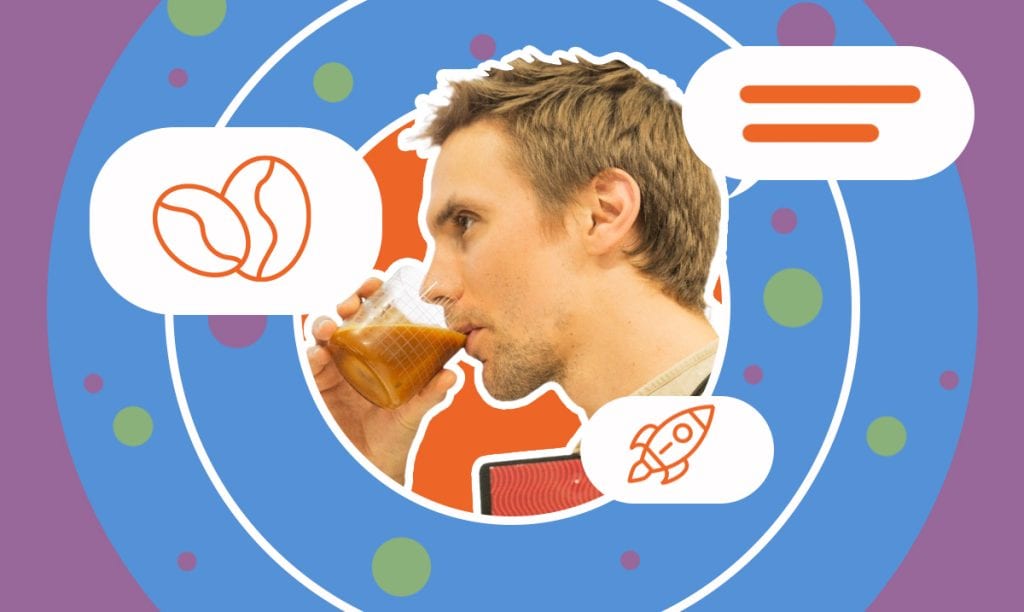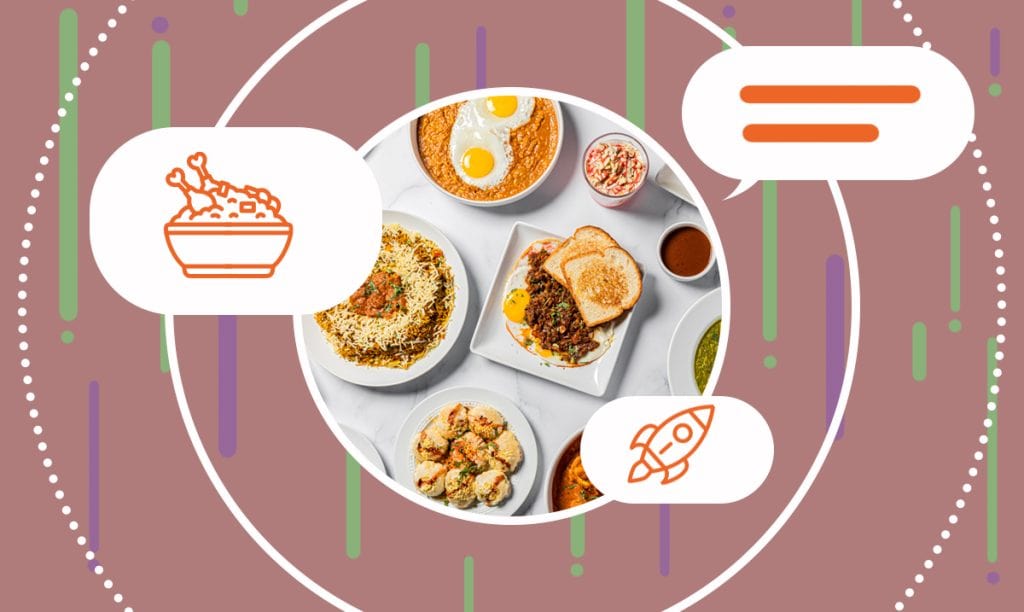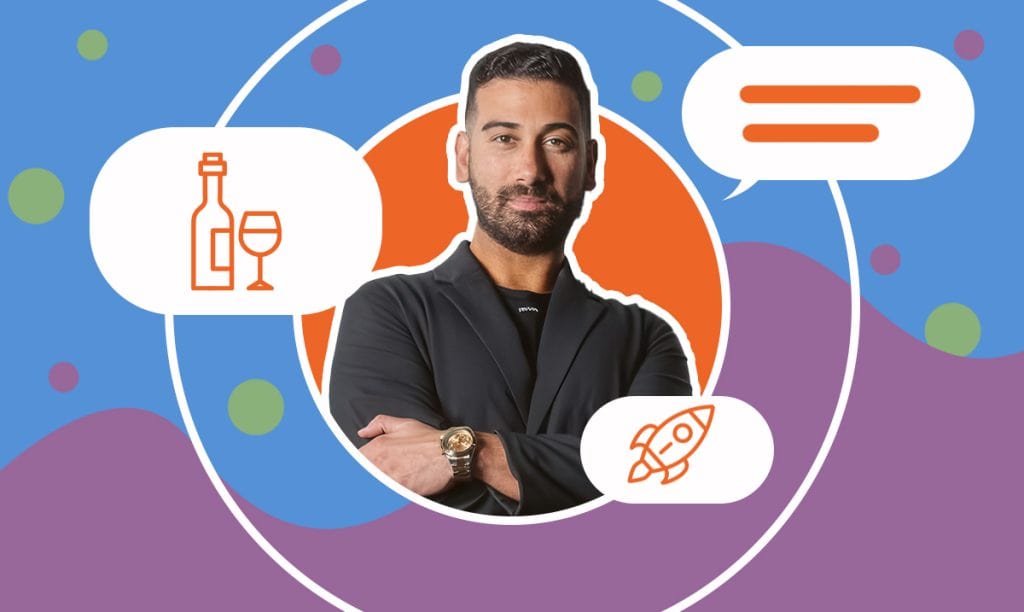In this interview, we sit down with Raimonds Selga, co-founder and board member of Kalve Coffee, a fast-growing specialty coffee brand based inLatvi ...
How to Start a Shrimp Farm: Insights from an Industry Pioneer
Written by: Carolyn Young
Carolyn Young is a business writer who focuses on entrepreneurial concepts and the business formation. She has over 25 years of experience in business roles, and has authored several entrepreneurship textbooks.
Published on May 21, 2024

Welcome to today’s interview with Robins McIntosh, the executive vice president of Charoen Pokphand Foods Public Company Limited (C.P.), a leading player in the global shrimp farming industry. With a profound passion for aquaculture and a wealth of experience, Robins has been instrumental in driving innovations and advancements within the sector. He’s also the CEO of Homegrown Shrimp, an independent subsidiary of C.P. in the US.
Today, we delve into his insights on the intricacies of shrimp farming, the technological advancements shaping the industry, and his strategic future plans. Join us as we explore the fascinating world of shrimp farming with a true industry pioneer.
Career Path and Industry Inspiration
SBS – What inspired you to work in the shrimp farming industry?
Robins – I work for people, which means I’m not the promoter or the funder but the executor. However, you can say I have been entrepreneurial in three or four projects in my life. The first would have been Belize, where we closed the shrimp pond cycle, not exchanging water with the environment and using clean shrimp. We did five or six things differently than people did then, and it was thought impossible to do. We did it out of necessity, but it worked very well, changed the shrimp world for the better, and was the impetus for what we have today in shrimp farming.
When I started in Belize, the world only produced 500,000 tons of shrimp. Belize didn’t make a big impact, but the technology and the visions it promoted made their way to Asia, and the largest company in Asia, Charoen Pokphand Foods Public Company Limited followed this work. The head of the company had seen me at a hatchery in Thailand in 1989. That hatchery was also different, using new technologies that nobody used. We had a genetics program, biosecurity, and sanitation — concepts that were not known in hatcheries in the eighties. After he visited that hatchery, he left with the impression I was some nutcase. Later on, when he recruited me, that’s exactly what he told me.
I left Thailand and went to Central America, and he followed my work in Belize because it became well known. In 2000, he wrote me telling me that he initially thought I was a nutcase, but after having followed what I had done, knowing the problems that Asia had developed and how things were going very badly, he would like me to come back and implement some of these things there. He recruited me with, I think, the best line that anybody has ever recruited me with. I was not fully committed, but he said, “In Belize, you painted a masterpiece. But it was a small masterpiece. In Asia, I will give you the world’s largest canvas, and you will paint the world’s largest masterpiece that could ever be created.” That cemented it for me. That was what I wanted to hear — we could take this to levels that I could never dream of in Belize.
I started in the business in the seventies, so most of the first 15–20 years were a failure. It’s what I call the learning period, where I learned everything that didn’t work, not what would work. I knew that didn’t work and something had to change. So, how do you change in an educated way or in a way that nobody else believes in? I received many letters in Belize saying that it was impossible to do what I had planned and that it was a lost cause. It was the same attitude that this person gave me when he saw the hatchery in Thailand. But in the end, it all proved to be correct, so I moved the business to Thailand, where they allowed me to take control of all the technologies, hatcheries, and farms. I created the first genetics program and did everything that needed to be done to create that large masterpiece. Then, we went to Indonesia, China, Vietnam, India, and the Philippines; wherever we took it, it blossomed.
When I went to Thailand, Thailand produced less than 200,000 tons of shrimp in 2001. By 2010, that number was 650,000 tons. That’s crazy and profitable. The same story then occurred in China, which was struggling. It went to a million tons. We took the story to Vietnam, and Vietnam was totally transformed. Wherever we took the story and transformed the technologies, the country blossomed to what we have now — five or six million tons in the world of much lower-cost shrimp than there were in 2001. The technologies have given a different viewpoint to growing shrimp more environmentally friendly, more sustainably, without antibiotics, and in a way that creates higher profit margins while doing it in a better way, helping the economies of those countries tremendously. That’s probably the best thing to be proud of. It’s not the profit you created for the company. It’s the jobs you created for a country and the number of children being educated at college.
Before shrimp farming succeeded in Thailand, they went around in animal-driven carts. Today, in those same areas, they have Mercedes, their children for the first generation go to college, they come back to the communities, and they build the communities up in many more ways — and this was all a result of the shrimp business. Some people, not myself, said, “Your work has resulted in millions and millions of jobs in Asia.” Anytime I visit those countries, for example, Vietnam, people meet me and invite me to the village houses to meet their children and invite me for tea. Those are their little ways of showing appreciation, and it does mean a lot to witness the impact you may have had a bit to do with.
Revolutionizing Aquaculture
SBS – Can you describe more about the technology behind recirculating aquaculture systems?
Robins – When I started doing this in Belize, this was the general rule: To have success and to create more shrimp, you needed to flow more water. It was considered a flow-through system. Some farms may change 300% of a farm’s volume every day, and that water would be flushed into the environment. That was their way of getting rid of the pollutants or the nitrogen. We couldn’t do that in Belize because it was a high-elevation farm, and we would’ve had to pump water there at a high cost. We couldn’t afford to flush water, so we created a system with zero water change. We would fill the pond and create internal bacteria that process the waste in the pond instead of flushing the waste out (it was what I call in-pond waste processing). In doing that, we only had to add water to top up from evaporation.
Likewise, because we were at a higher elevation and the expenses were higher, we had to go with higher densities, so we intensified the system, meaning we had to add aeration, which nobody in the Americas did then. Also, shrimp farmers at that time were starting to have problems with shrimp health, leading to many antibiotics being used. I call it nursing the shrimp. They weren’t treating disease. They were nursing shrimp to a harvest. Otherwise, there would be no harvest.
We adopted a new concept that was being developed in Hawaii called SPF shrimp, which is certified disease- and pathogen-free shrimp. In the Americas, most people considered this shrimp weak and impossible to use. It was. It would never replace the wild shrimp. That was the impression, and many, many people wrote to me that when I committed to bringing in these Hawaiian shrimp, it wouldn’t work and was a waste of time. However, it worked better than anybody could have envisioned it working. The first harvest beat all of our estimates with the most beautiful shrimp I had seen in eight years. It was a total change when we put those shrimp into a closed system with aeration and management. In some ways, there was a lot of lucky guessing going on. I like to think it was educated guessing, but it worked against all grains, and it continued to work for five years until I left.
Essentially, those are the same principles I took to Asia. We closed those farm systems, so they were recirculating within the farm, not from the ocean. There had been SPF shrimp introduced before. Taiwan and China had done very well with it, but they misunderstood the shrimp. They understood SPF or this “disease-free” as a genetic characteristic that they could continue to reproduce from ponds, so the stocks deteriorated very fast, and the industries collapsed. Nobody wanted SPF in Asia. They looked at that shrimp as collapsing because they didn’t understand it. The first generation was very good, but it wasn’t genetic. It was health. You have to create a disease-free environment to produce this shrimp. We made the first disease-free compartments, where we put a real genetics program. At the time, there was no serious genetics in shrimp, so the company I work for, C.P., invested large amounts of money in creating a genetic program with the SPF concept. That program has resulted in a complete change of the animal and was highly contributory to the success of Asia and shrimp farming.
They brought me to Asia for a holiday, but I didn’t get a holiday. Instead, they took me to every farm in Vietnam, Indonesia, and Thailand. I told the owner it was simple. It wasn’t the management or anything else to blame for the problem. It was the health of the shrimp. Wild shrimp had gone bad, and they needed to domesticate the shrimp and get a disease-free stock. I told them it would take seven or eight years to do that. They, of course, couldn’t wait seven or eight years. As a short-term solution, I brought in the white shrimp that I already knew and developed, and that’s when the white shrimp, vannamei, changed Asia. Before that, Asia produced black tiger shrimp, and most shrimp sold in the United States and worldwide were black tiger because Asia was the big producer. When we shifted the dynamic from the black tiger to white shrimp, finding the former in America became very hard. Now it’s all white shrimp. This dynamic change from the black tiger to the white shrimp happened in 2004 because of these new clean stocks that performed very well initially.
When I started this, I brought in the first clean shrimp from Hawaii in March 2001. When we got ready to sell these, the company’s president called us in, brought a sales team in, and told us to sell that shrimp. The sales team refused, saying they’d tried these shrimp before, the farmers didn’t want them, and they did worse than the black tiger. I told them that was not exactly what they sold before, but I understood the hesitation. The president said he wasn’t asking us to sell the shrimp; he was telling us to do it. I went back to my office and suggested giving the first animals away to five or six farms. We only had eight million, and we gave them away. Within 30 days, the phone started ringing off the hook. Farmers had already seen the difference, and it went exponential from there. We peaked in 2007 at three billion animals in Thailand a month. Again, there was a huge exponential shift, and farmers had to learn. Once we gave the farmers good tools and explained the differences in managing them, the Thai industry and then the Asian industry changed.
At the same time, I started the domestication program for black tiger shrimp. Sure enough, it took about eight years. Nobody else did it, and there was only one other company with these animals in the world (another company out of Hawaii). We did it and had these animals in 2011. We then started doing the same genetic improvement, and today, the black tiger is making a comeback because these animals are so beautiful and fantastic, and they are starting to make dents in the Vietnamese market. Malaysia is probably the first country to go from vannamei back to black tiger, and where these new black tigers are, there’s a tremendous impact. Again, it’s the health, genetic improvement, and improved farming management.
Market Dynamics: Black Tiger vs. White Shrimp
SBS – Do you think there will be a fight between the black tiger and the white shrimp for market dominance?
Robins – Well, there is a fight now. The white shrimp will win. Because of the genetic improvement we’ve done for 18 years, the white shrimp grows three times faster today than the black tiger, whereas the black tiger historically grew twice as fast as the white shrimp. Also, the white shrimp can grow as big as the black tiger. We are also making improvements to the black tiger, and I’ve learned to say that never is a long time, so in five years, maybe the black tiger will outperform the white shrimp. It takes time. Genetics is time and consistency. But the story is the same — have clean shrimp, improve the shrimp to a domesticated stock, change the management, make sure that you’re not polluting your environment, take care of your waste, and not use antibiotics.
Regarding antibiotics, it was very clear that if you have healthy shrimp, there’s no need for antibiotics. It’s known that antibiotic use, unless it’s prescribed for a specific disease with specific use, is not good for you. But these days, much of the reputation of antibiotics and shrimp remains from the old days, when it was a requirement to nurse a population through; otherwise, there would be no harvest.
Ensuring Quality from Farm to Plate
SBS – How do you ensure the quality and freshness of a shrimp is the best possible when selling from the farm to the customer?
Robins – There’s still a lot of consumer education to happen because there’s still residual information about the destruction of coastal environments. There’s still a residual story of antibiotics. There are other residual stories out there. But modern shrimp farming is very different. Again, it comes down to the quality. Many of the farms today are built close to processing plants, so shrimp can be delivered live to processing, and the attributes of a fresh, live shrimp are delivered to a customer another continent away. The quality is much better than it used to be.
One of the problems that still exists is consumers. I don’t know if this is true in Europe, but in the Americas, people have been brought up on chemicalized shrimp, and they consider that a good shrimp. If you give them a chemical-free shrimp, they score that lower quality than if you give them a fresh shrimp. Americans are used to pumping their shrimp up with water. They pump their chickens up, too. You cook a chicken, and it all becomes water. It’s the same way with their shrimp, but if it doesn’t do that, they feel that that’s a bad shrimp. However, I think there’s a lot more awareness now. Many health issues are becoming a conversation now, and a lot of it is around overly processed foods.
Strategy and Success
SBS – When you were starting, people didn’t believe you, but they came around when you proved your strategy. Would you say you didn’t use any marketing strategy to attract new customers, but people came to you via word-of-mouth recommendation?
Robins – I believe in demonstration, not in talk, and that’s a battle I always fight with marketers. They want to come up with fancy phrases and descriptions. I sell with performance. I sell with, “Try it, you’ll like it.” When you tell people what will happen, it doesn’t always meet their expectations. There’s disappointment, and oftentimes, the marketers get ahead of themselves, so it’s a short-term success.
When I started selling our shrimp, I was very, very good, but I didn’t market anything. I just encouraged people to try the shrimp. The shrimp’s performance sells. Word of mouth spreads. My best salespeople are the farmers and the hatcheries themselves, who speak to their neighbors. If the product doesn’t prove itself, it’s not worth anything.
Future Ventures
SBS – What do you plan for yourself for the next couple of years? You talk about the black tiger, but are there any other plans in the works?
Robins – I’m in the United States trying to establish a successful farm, which has never been done before and is quite challenging. It requires a whole different set of perspectives in terms of automation, labor costs, and regulations. There are many roadblocks to success, and we have to compete against very low-cost imports. Again, your only marketing tool is to market fresh because imports can’t come here fresh. You need to differentiate what you’re doing and provide a higher quality product that the consumer will eventually realize is better than buying a cheap import. There’s nothing wrong with a cheap import, but it is frozen. Yes, it lasts longer, but fresh shrimp does taste better. If you’re a gourmet, fresh is always better than frozen.
Navigating New Markets
SBS – Are you afraid of that challenge because you established so many things in Asia, or are you willing to change the market in the US?
Robins – This market will never replace Asia or South America. There’s always going to be the Walmart. This is for the most discerning consumer. It’s not for the mass consumer. There is a large market for these types of consumers, so it’s a matter of spreading the word, making the product available, producing it efficiently, and continually working on reducing the cost. There are ways of reducing costs, but now we’re doing the first generation, and we’re only three years into this.
If you look at a similar comparison to shrimp in general, Ecuador started producing shrimp in 1972, but they didn’t hit the big time until 2018. It was a long gestation period. Every generation, it’ll get better. The next one I would do would be different from the one I’m doing now. It would be better because of learning what went wrong with this one and how it could be made better. It would have been foolish to believe you’ll get it on the first try, but you learn. It’s all about learning and moving forward.
As a matter of policy, I’ve always told myself, “You never want to be first.” In Ecuador, those first farms, if they were built for a million dollars, they sold for 500,000 and then for 200,000, and finally, when they were down to 100,000 valuations, they started making money. When you’re the first, you’ll spend a lot more money than if you’re the second, third, or fourth. In this case, there was nothing before, so you’re forced into a position to be first, just like in Belize. That was a first. It worked out much better than I would have predicted. But again, we’ve learned, and I do things much differently today than I did back then, and it’s better today than it was back then. That was what I call the Model T, and now we’re in a more of a 1960s car, but it’ll still get better.
Read also: How Karlanea Brown Leads the Way in Indoor Shrimp Farming
Subscribe to Our Newsletter
and gain insider access to cutting-edge business insights and trends.
Featured Resources

How Kalve Makes High-End Coffee Accessible for Everyone
Published on April 3, 2025
Read Now

How Eggholic is Bringing Authentic Indian Street Food to the US
Published on February 25, 2025
In this interview, we speak with Bhavana Singh, the visionary behind Eggholic, a restaurant that brings the authentic flavors of Gujarat’segg- ...
Read Now

How a Historic Theater Became Houston’s Chic Bar
Published on January 2, 2025
Nestled in the heart of Houston’s Montrose neighborhood, Clarkwood is more than just a chic wine and cocktail bar— it’s a celebration ofhistor ...
Read Now
Comments